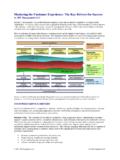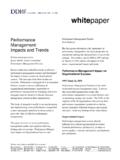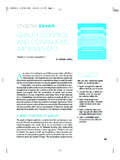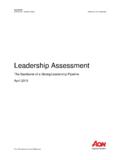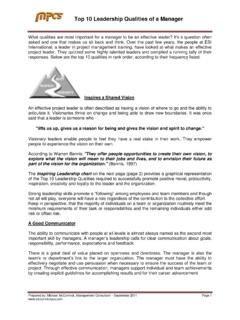Transcription of Course18:Leadership - exinfm
1 Course 18: LeadershipPrepared by: Matt H. Evans, CPA, CMA, CFMThis course provides a concise overview on leadership ,including leadership behavior, measuring leadership andan overall framework for understanding leadership . Thiscourse is recommended for 2 hours of ContinuingProfessional you are seeking credit for takingthis course, then you need to download and use the exe file version of this course files and supplementalmaterials are posted on the internet in Financial Management2 Fundamental ConceptsAll organizations must challenge themselves in a very bold and daring way by asking: What is leadership ? How do werecognize leadership ? Where does leadership reside within our organization? How do we nourish and grow leadership ?
2 How do we leverage our current leadership ? Can we measure leadership ? Is it possible to make leadership a core competency?Most organizations now realize that they must embark on this unusual journey searching and understanding leadership . One reason behind this trend is quite simple:The discipline of management is giving way to the discipline of obvious point concernsperformance. Look at any great team or organizationand you invariably see great leadership . Winning sports teams provide good examples,but numerous examples abound in the public, private, and non-profit sectors. So if youwant to create a high performance organization, you must have strong is one of those fundamental building blocks that drives everything else.
3 Thepotential of the individual and the organization ultimately boils down to short course is designedto take you through a journey about leadership exploringthe theory and applications of leadership . We will dig into the nuts and bolts things likeleadership behavior and characteristics, as well as formal models for measuring andassessing leadership . We will also (at some risk) stick our neck out and build aframework for developing leadership atvariouslevels. Even though this might besomewhat of a subjective exercise, leadership is simply too important not to at leastmake the attempt at placingleadership into an overall kick-off our leadership journey, let s start with a basic level of how we might viewleadership.
4 We know that leadership is something that goes beyond heroic acts. Werecognize that leadership is about values and how people communicate and live bythese values. We also realize that these values must be shared for leadership to work. Inorder to apply shared values, leaders must connect to might be saying to yourself well this is easy so far, but let s reflect on what acharacter in an E. B. White novel once said: I predict a bright future for complexity. Thepoint is simple the business of leadership is considerably complex. So why isleadership so complex? One reason has to do with everyone s Reciprocal Process3 People tend to superimpose mental models or view leadership through a portal.
5 On theflip side, leaders have expectations of followers. Therefore, the leadership process isvery reciprocal the leader has needs and the follower has needs. The question is doboth perceive that each other s needs are being met. And in many situations, the answeris No! Thus, the leadership process is often bumpy, filled with unmet are critical to leaders from a quality control perspective. Competingviewpoints and opinions from others will help validate and keep the leader in a lane ofreality. This dynamic dialogue between the leader and the follower keeps the whole thingin order for the reciprocal process to work, there must be trust between the leader andthe follower. Trust is a pre-requisite for every leader and if leaders fail to act in an openand honest way, then trust cannot be earned.
6 In order to solidify trust, leaders must: Care about their followers in a thoughtful way, but at the same time, hold themaccountable for what they do. Honor their commitments to those they serve do as you say. Communicate and reach followers in a way that shows respect, recognizing thatdifferences are a sign ofprogress. Follow a set of values that others can identify with integrity, courage, reliability,fairness, and a lack of of the qualities needed for trust will be further discussed in this short course things like intimacy, collaboration, and service to others. Trust is like a thread runningthrough everything, providing a grounding pillar for making leadership happen. Andunfortunately, it takes considerable time and effort to secure trust, and given one slip-upin the eyes of the follower, trust can instantly of numerous writings about leadership , we can make certain distinctionsbetween leadership and management.
7 Organizations need both leaders and managers,but the reality is managers dominate most organizations. Here is a quick list thathighlights some of the differences:ManagingLeadingValues resultsValues relationshipsRelates to positionsLow regard for positionsTakes few risksTakes large risksSomewhat impersonalPersonal and caringConforms to rules of othersNot receptive to the rules of othersStatus quo low innovationNew ideas high innovationFunctional analyze, evaluate, solveNon Functional inspire, motivateManaging vs. LeadingConnecting to theFollower through Trust4If you review this list, you can clearly see that the pathof a leader is considerably moredifficult than the manager. This is one of the reasons why we see so few leaders in mostorganizations.
8 Additionally, organizations tend to impede leadership hierarchies thatconstrain information flows, internal politics, conflicting agendas, pressure to conform,and a host of other attributes that make leadership incredibly of the most important values of a leader is to provide overall direction. Only leaderscan shape and change the context of vision articulating passion, candor, and integrity providing a curious and daring exploration of what should be. Good leaders inventthemselves and the future for others. Warren Bennis1, one the best contemporarythinkers on leadership , seems to imply that thedifference between a leader and amanager is like the difference between those who can master the context of things andthose who cannot.
9 Bennis summarizes these differences in his book:Learning to Lead:A Workbook on Becoming a Leader: Managers administer while leaders innovate. Managers tend to copy while leaders are more original in their style. Managers seek to maintain the environment while leaders try to develop it. Managers rely on control, leaders inspires trust. Managers are focused on the process and systems, leaders are highly focusedon the people behind the processes and systems. Managers tend to be short-term thinkers and leaders have a much longer termperspective. Managers routinely ask: How and When? Leaders will ask: What and Why? Managers imitate according to the culture and politics of the organization. Theleader isless likely to comply with culture and contemporary thinker on leadership , John P.
10 Kotter2, provides good insights onthe differences between leadershipand management. Unlike management, leadershipdoes not produce consistency, but change. leadership is about generating movementsand currents within the organization. Leaders produce change through the processes ofestablishing direction through vision and strategy, aligning people whose cooperation isneeded to achieve the vision, and motivating and inspiring them to overcome thebarriers to books by Warren Bennis include:On Becoming a LeaderandLeaders: Strategies for TakingCharge2 Books by John P. Kotter include:Leading Change, The Heart of Change, andOn What Leaders Really Do In business, we see an evolution of the concept of leadership .



